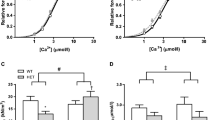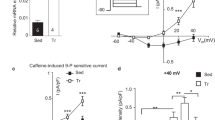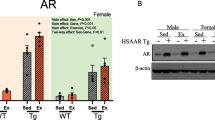Abstract
The Na+/H+ exchanger isoform 1 (NHE1) has been implicated in various cardiac pathologies including ischemia/reperfusion damage to the myocardium and cardiac hypertrophy. It is known that NHE1 levels increase in cardiac disease and we have recently demonstrated that expression of an activated NHE1 protein promotes cardiac hypertrophy in the mouse myocardium. We examined the gender-specific effects of exercise in combination with elevated cardiac expression of NHE1 on the myocardium in mice. Control mice and transgenic mice expressing elevated levels of wild type NHE1 and activated NHE1 were examined. There were gender-specific differences in the effects of NHE1 with exercise. Exercised wild type male mice showed a tendency toward increased heart weight. This was not apparent in female mice expressing elevated NHE1 levels. In some transgenic female mice, there was a significant decrease in the size of the exercised hearts, which was different from what occurred with male mice. Body weight was maintained in exercised control and transgenic male mice; however, it decreased in female mice with exercise more so in transgenic female mice expressing elevated levels of NHE1. Female mice expressing activated NHE1 had elevated HW/BW ratios compared to males, and this was exaggerated by exercise. These results suggest that gender-specific activation of NHE1 may be critical and that NHE1 plays a more critical role in promoting some types of hypertrophy in females in comparison with males.






Similar content being viewed by others
References
Fliegel L, Wang H (1997) Regulation of the Na+/H+ exchanger in the mammalian myocardium. J Mol Cell Cardiol 29:1991–1999
Fliegel L (2001) Regulation of myocardial Na+/H+ exchanger activity. Basic Res Cardiol 96:301–305
Cingolani HE, Ennis IL (2007) Sodium-hydrogen exchanger, cardiac overload, and myocardial hypertrophy. Circulation 115:1090–1100
Malo ME, Fliegel L (2006) Physiological role and regulation of the Na+/H+ exchanger. Can J Physiol Pharmacol 84:1081–1095
Fliegel L, Dyck JRB, Wang H, Fong C, Haworth RS (1993) Cloning and analysis of the human myocardial Na+/H+ exchanger. Mol Cell Biochem 125:137–143
Avkiran M (2001) Protection of the ischaemic myocardium by Na+/H+ exchange inhibitors: potential mechanisms of action. Basic Res Cardiol 96:306–311
Karmazyn M, Sawyer M, Fliegel L (2005) The Na(+)/H(+) exchanger: a target for cardiac therapeutic intervention. Curr Drug Targets Cardiovasc Haematol Disord 5:323–335
Karmazyn M, Sostaric JV, Gan XT (2001) The myocardial Na+/H+ exchanger: a potential therapeutic target for the prevention of myocardial ischaemic and reperfusion injury and attenuation of postinfarction heart failure. Drugs 61:375–389
Harris C, Fliegel L (1999) Amiloride and the Na+/H+ exchanger protein. Mechanism and significance of inhibition of the Na+/H+ exchanger. Int J Mol Med 3:315–321
Kemp G, Young H, Fliegel L (2008) Structure and function of the human Na+/H+ exchanger isoform 1. Channels (Austin) 2:329–336
Avkiran M, Cook AR, Cuello F (2008) Targeting Na+/H+ exchanger regulation for cardiac protection: A RSKy approach? Curr Opin Pharmacol 8:133–140
Gan XT, Chakrabarti S, Karmazyn M (1999) Modulation of Na+/H+ exchange isoform 1 mRNA expression in isolated rat hearts. Am J Physiol 277:H993–H998
Dyck JRB, Maddaford T, Pierce GN, Fliegel L (1995) Induction of expression of the sodium-hydrogen exchanger in rat myocardium. Cardiovascular Res 29:203–208
Karmazyn M, Liu Q, Gan XT, Brix BJ, Fliegel L (2003) Aldosterone increases NHE-1 expression and induces NHE-1-dependent hypertrophy in neonatal rat ventricular myocytes. Hypertension 42:1171–1176
Yokoyama H, Gunasegaram S, Harding SE, Avkiran M (2000) Sarcolemmal Na+/H+ exchanger activity and expression in human ventricular myocardium. J Am Coll Cardiol 36:534–540
Ennis IL, Escudero EM, Console GM, Camihort G, Dumm CG, Seidler RW, Camilion de Hurtado MC, Cingolani HE (2003) Regression of isoproterenol-induced cardiac hypertrophy by Na+/H+ exchanger inhibition. Hypertension 41:1324–1329
Counillon L, Pouyssegur J (2000) The expanding family of eukaryotic Na+/H+ exchangers. J Biol Chem 275:1–4
Mraiche F, Oka T, Gan XT, Karmazyn M, Fliegel L (2011) Activated NHE1 is required to induce early cardiac hypertrophy in mice. Basic Res Cardiol 106:603–616
Coccaro E, Mraiche F, Malo M, Vandertol-Vanier H, Bullis B, Robertson M, Fliegel L (2007) Expression and characterization of the Na(+)/H (+) exchanger in the mammalian myocardium. Mol Cell Biochem 302:145–155
Imahashi K, Mraiche F, Steenbergen C, Murphy E, Fliegel L (2007) Overexpression of the Na+/H+ exchanger and ischemia-reperfusion injury in the myocardium. Am J Physiol Heart Circ Physiol 292:H2237–H2247
Slepkov ER, Chow S, Lemieux MJ, Fliegel L (2004) Proline residues in transmembrane segment IV are critical for activity, expression and targeting of the Na+/H+ exchanger isoform 1. Biochem J 379:31–38
Dawn B, Xuan YT, Marian M, Flaherty MP, Murphree SS, Smith TL, Bolli R, Jones WK (2001) Cardiac-specific abrogation of NF- kappa B activation in mice by transdominant expression of a mutant I kappa B alpha. J Mol Cell Cardiol 33:161–173
Murase T, Haramizu S, Shimotoyodome A, Tokimitsu I, Hase T (2006) Green tea extract improves running endurance in mice by stimulating lipid utilization during exercise. Am J Physiol Regul Integr Comp Physiol 290:R1550–R1556
Juel C (1998) Skeletal muscle Na+/H+ exchange in rats: pH dependency and the effect of training. Acta Physiol Scand 164:135–140
Pierce GN, Kutryk MJ, Dhalla KS, Beamish RE, Dhalla NS (1984) Biochemical alterations in heart after exhaustive swimming in rats. J Appl Physiol 57:326–331
Pierce GN, Sekhon PS, Meng HP, Maddaford TG (1989) Effects of chronic swimming training on cardiac sarcolemmal function and composition. J Appl Physiol 66:1715–1721
Konhilas JP, Maass AH, Luckey SW, Stauffer BL, Olson EN, Leinwand LA (2004) Sex modifies exercise and cardiac adaptation in mice. Am J Physiol Heart Circ Physiol 287:H2768–H2776
Bupha-Intr T, Wattanapermpool J, Pena JR, Wolska BM, Solaro RJ (2007) Myofilament response to Ca2+ and Na+/H+ exchanger activity in sex hormone-related protection of cardiac myocytes from deactivation in hypercapnic acidosis. Am J Physiol Regul Int Comp Physiol 292:R837–R843
Kilic A, Javadov S, Karmazyn M (2009) Estrogen exerts concentration-dependent pro-and anti-hypertrophic effects on adult cultured ventricular myocytes. Role of NHE-1 in estrogen-induced hypertrophy. J Mol Cell Cardiol 46:360–369
Lightfoot JT, Turner MJ, Daves M, Vordermark A, Kleeberger SR (2004) Genetic influence on daily wheel running activity level. Physiol Genomics 19:270–276
Wu J, Wang XX, Takasaki M, Ohta A, Higuchi M, Ishimi Y (2001) Cooperative effects of exercise training and genistein administration on bone mass in ovariectomized mice. J Bone Min Res 16:1829–1836
Patel H, Hoffman-Goetz L (2002) Effects of oestrogen and exercise on caspase-3 activity in primary and secondary lymphoid compartments in ovariectomized mice. Acta Physiol Scand 176:177–184
Foryst-Ludwig A, Kreissl MC, Sprang C et al (2011) Sex differences in physiological cardiac hypertrophy are associated with exercise-mediated changes in energy substrate availability. Am J Physiol Heart Circ Physiol 301:H115–H122
Malo ME, Li L, Fliegel L (2007) Mitogen-activated protein kinase-dependent activation of the Na+/H+ exchanger is mediated through phosphorylation of amino acids Ser770 and Ser771. J Biol Chem 282:6292–6299
Coccaro E, Karki P, Cojocaru C, Fliegel L (2009) Phenylephrine and sustained acidosis activate the neonatal rat cardiomyocyte Na+/H+ exchanger through phosphorylation of amino acids Ser770 and Ser771. Am J Physiol Heart Circ Physiol 297:H846–H858
Williamson DL, Kubica N, Kimball SR, Jefferson LS (2006) Exercise-induced alterations in extracellular signal-regulated kinase 1/2 and mammalian target of rapamycin (mTOR) signalling to regulatory mechanisms of mRNA translation in mouse muscle. J Physiol 573:497–510
Iemitsu M, Maeda S, Jesmin S, Otsuki T, Kasuya Y, Miyauchi T (2006) Activation pattern of MAPK signaling in the hearts of trained and untrained rats following a single bout of exercise. J Appl Physiol 101:151–163
Karmazyn M (2012) Mechanism underlying development of cardiomyocyte hypertrophy via Na-H exchange stimulation. In: Dhalla NS, Nagano M, Ostada B (eds) Molecular defects in cardiovascular disease. Springer, New York, pp 185–195
Xue J, Mraiche F, Zhou D, Karmazyn M, Oka T, Fliegel L, Haddad GG (2010) Elevated myocardial Na+/H+ exchanger isoform 1 activity elicits gene expression that leads to cardiac hypertrophy. Physiol Genomics 42:374–383
Acknowledgments
This study was supported by funding from the Canadian Institutes of Health Research to LF. LF is supported by an Alberta Ingenuity for Health Research Scientist award.
Author information
Authors and Affiliations
Corresponding author
Rights and permissions
About this article
Cite this article
Vanier, H.V., Mraiche, F., Li, X. et al. Gender-specific effects of exercise on cardiac pathology in Na+/H+ exchanger overexpressing mice. Mol Cell Biochem 368, 103–110 (2012). https://doi.org/10.1007/s11010-012-1348-1
Received:
Accepted:
Published:
Issue Date:
DOI: https://doi.org/10.1007/s11010-012-1348-1




